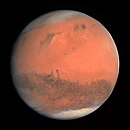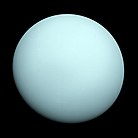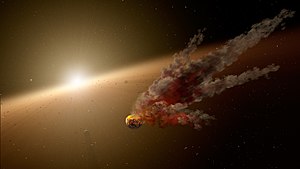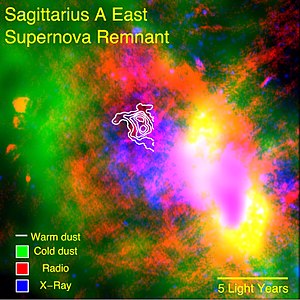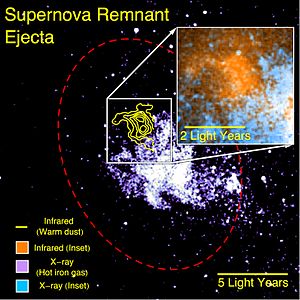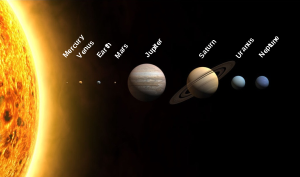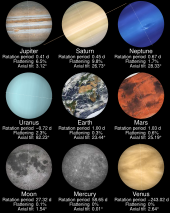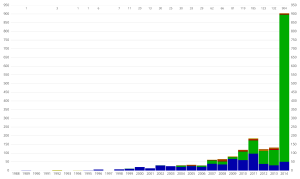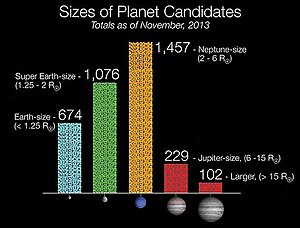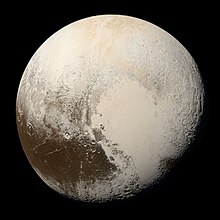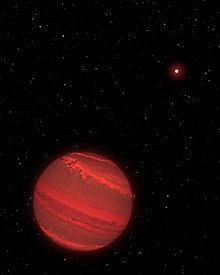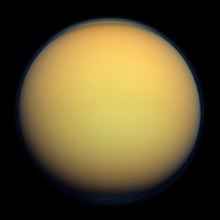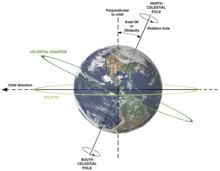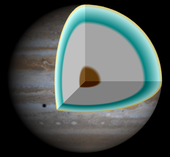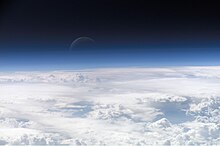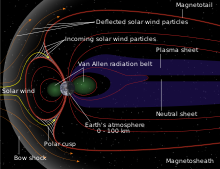| ||||
The eight known planets of the Solar System:
Shown in order from the Sun and in true color. Sizes are not to scale. |
A planet is an astronomical body orbiting a star or stellar remnant that is massive enough to be rounded by its own gravity, is not massive enough to cause thermonuclear fusion, and – according to the International Astronomical Union but not all planetary scientists – has cleared its neighbouring region of planetesimals.
The term planet is ancient, with ties to history, astrology, science, mythology, and religion. Apart from Earth itself, five planets in the Solar System are often visible to the naked eye. These were regarded by many early cultures as divine, or as emissaries of deities. As scientific knowledge advanced, human perception of the planets changed, incorporating a number of disparate objects. In 2006, the International Astronomical Union (IAU) officially adopted a resolution defining planets within the Solar System. This definition is controversial because it excludes many objects of planetary mass based on where or what they orbit. Although eight of the planetary bodies discovered before 1950 remain "planets" under the current definition, some celestial bodies, such as Ceres, Pallas, Juno and Vesta (each an object in the solar asteroid belt), and Pluto (the first trans-Neptunian object discovered), that were once considered planets by the scientific community, are no longer viewed as planets under the current definition of planet.
The planets were thought by Ptolemy to orbit Earth in deferent and epicycle motions. Although the idea that the planets orbited the Sun had been suggested many times, it was not until the 17th century that this view was supported by evidence from the first telescopic astronomical observations, performed by Galileo Galilei. About the same time, by careful analysis of pre-telescopic observational data collected by Tycho Brahe, Johannes Kepler found the planets' orbits were elliptical rather than circular. As observational tools improved, astronomers saw that, like Earth, each of the planets rotated around an axis tilted with respect to its orbital pole, and some shared such features as ice caps and seasons. Since the dawn of the Space Age, close observation by space probes has found that Earth and the other planets share characteristics such as volcanism, hurricanes, tectonics, and even hydrology.
Planets in the Solar System are divided into two main types: large low-density giant planets, and smaller rocky terrestrials. There are eight planets in the Solar System according to the IAU definition. In order of increasing distance from the Sun, they are the four terrestrials, Mercury, Venus, Earth, and Mars, then the four giant planets, Jupiter, Saturn, Uranus, and Neptune. Six of the planets are orbited by one or more natural satellites, the two exceptions being Mercury and Venus.
Several thousands of planets around other stars ("extrasolar planets" or "exoplanets") have been discovered in the Milky Way. As of 1 November 2021, 4,864 known extrasolar planets in 3,595 planetary systems (including 803 multiple planetary systems), ranging in size from just above the size of the Moon to gas giants about twice as large as Jupiter, have been discovered, out of which more than 100 planets are the same size as Earth, nine of which are at the same relative distance from their star as Earth from the Sun, i.e. in the circumstellar habitable zone. On 20 December 2011, the Kepler Space Telescope team reported the discovery of the first Earth-sized extrasolar planets, Kepler-20e and Kepler-20f, orbiting a Sun-like star, Kepler-20. A 2012 study, analyzing gravitational microlensing data, estimates an average of at least 1.6 bound planets for every star in the Milky Way. Around one in five Sun-like stars is thought to have an Earth-sized planet in its habitable zone.
History
The idea of planets has evolved over its history, from the divine lights of antiquity to the earthly objects of the scientific age. The concept has expanded to include worlds not only in the Solar System, but in hundreds of other extrasolar systems. The ambiguities inherent in defining planets have led to much scientific controversy.
The five classical planets of the Solar System, being visible to the naked eye, have been known since ancient times and have had a significant impact on mythology, religious cosmology, and ancient astronomy. In ancient times, astronomers noted how certain lights moved across the sky, as opposed to the "fixed stars", which maintained a constant relative position in the sky. Ancient Greeks called these lights πλάνητες ἀστέρες (planētes asteres, "wandering stars") or simply πλανῆται (planētai, "wanderers"), from which today's word "planet" was derived. In ancient Greece, China, Babylon, and indeed all pre-modern civilizations, it was almost universally believed that Earth was the center of the Universe and that all the "planets" circled Earth. The reasons for this perception were that stars and planets appeared to revolve around Earth each day and the apparently common-sense perceptions that Earth was solid and stable and that it was not moving but at rest.
Babylon
The first civilization known to have a functional theory of the planets were the Babylonians, who lived in Mesopotamia in the first and second millennia BC. The oldest surviving planetary astronomical text is the Babylonian Venus tablet of Ammisaduqa, a 7th-century BC copy of a list of observations of the motions of the planet Venus, that probably dates as early as the second millennium BC. The MUL.APIN is a pair of cuneiform tablets dating from the 7th century BC that lays out the motions of the Sun, Moon, and planets over the course of the year. The Babylonian astrologers also laid the foundations of what would eventually become Western astrology. The Enuma anu enlil, written during the Neo-Assyrian period in the 7th century BC, comprises a list of omens and their relationships with various celestial phenomena including the motions of the planets. Venus, Mercury, and the outer planets Mars, Jupiter, and Saturn were all identified by Babylonian astronomers. These would remain the only known planets until the invention of the telescope in early modern times.
Greco-Roman astronomy
| 1 Moon |
2 Mercury |
3 Venus |
4 Sun |
5 Mars |
6 Jupiter |
7 Saturn |
The ancient Greeks initially did not attach as much significance to the planets as the Babylonians. The Pythagoreans, in the 6th and 5th centuries BC appear to have developed their own independent planetary theory, which consisted of the Earth, Sun, Moon, and planets revolving around a "Central Fire" at the center of the Universe. Pythagoras or Parmenides is said to have been the first to identify the evening star (Hesperos) and morning star (Phosphoros) as one and the same (Aphrodite, Greek corresponding to Latin Venus), though this had long been known by the Babylonians. In the 3rd century BC, Aristarchus of Samos proposed a heliocentric system, according to which Earth and the planets revolved around the Sun. The geocentric system remained dominant until the Scientific Revolution.
By the 1st century BC, during the Hellenistic period, the Greeks had begun to develop their own mathematical schemes for predicting the positions of the planets. These schemes, which were based on geometry rather than the arithmetic of the Babylonians, would eventually eclipse the Babylonians' theories in complexity and comprehensiveness, and account for most of the astronomical movements observed from Earth with the naked eye. These theories would reach their fullest expression in the Almagest written by Ptolemy in the 2nd century CE. So complete was the domination of Ptolemy's model that it superseded all previous works on astronomy and remained the definitive astronomical text in the Western world for 13 centuries. To the Greeks and Romans there were seven known planets, each presumed to be circling Earth according to the complex laws laid out by Ptolemy. They were, in increasing order from Earth (in Ptolemy's order and using modern names): the Moon, Mercury, Venus, the Sun, Mars, Jupiter, and Saturn.
Cicero, in his De Natura Deorum, enumerated the planets known during the 1st century BCE using the names for them in use at the time:
- "But there is most matter for wonder in the movements of the five stars which are falsely called wandering; falsely, because nothing wanders which through all eternity preserves its forward and retrograde courses, and its other movements, constant and unaltered. ... For instance, the star which is farthest from the earth, which is known as the star of Saturn, and is called by the Greeks Φαίνων (Phainon), accomplishes its course in about thirty years, and though in that course it does much that is wonderful, first preceding the sun, and then falling off in speed, becoming invisible at the hour of evening, and returning to view in the morning, it never through the unending ages of time makes any variation, but performs the same movements at the same times. Beneath it, and nearer to the earth, moves the planet of Jupiter, which is called in Greek Φαέθων (Phaethon); it completes the same round of the twelve signs in twelve years, and performs in its course the same variations as the planet of Saturn. The circle next below it is held by Πυρόεις (Pyroeis), which is called the planet of Mars, and traverses the same round as the two planets above it in four and twenty months, all but, I think, six days. Beneath this is the planet of Mercury, which is called by the Greeks Στίλβων (Stilbon); it traverses the round of the zodiac in about the time of the year's revolution, and never withdraws more than one sign's distance from the sun, moving at one time in advance of it, and at another in its rear. The lowest of the five wandering stars, and the one nearest the earth, is the planet of Venus, which is called Φωσϕόρος (Phosphoros) in Greek, and Lucifer in Latin, when it is preceding the sun, but Ἕσπερος (Hesperos) when it is following it; it completes its course in a year, traversing the zodiac both latitudinally and longitudinally, as is also done by the planets above it, and on whichever side of the sun it is, it never departs more than two signs' distance from it."
India
In 499 CE, the Indian astronomer Aryabhata propounded a planetary model that explicitly incorporated Earth's rotation about its axis, which he explains as the cause of what appears to be an apparent westward motion of the stars. He also believed that the orbits of planets are elliptical. Aryabhata's followers were particularly strong in South India, where his principles of the diurnal rotation of Earth, among others, were followed and a number of secondary works were based on them.
In 1500, Nilakantha Somayaji of the Kerala school of astronomy and mathematics, in his Tantrasangraha, revised Aryabhata's model. In his Aryabhatiyabhasya, a commentary on Aryabhata's Aryabhatiya, he developed a planetary model where Mercury, Venus, Mars, Jupiter and Saturn orbit the Sun, which in turn orbits Earth, similar to the Tychonic system later proposed by Tycho Brahe in the late 16th century. Most astronomers of the Kerala school who followed him accepted his planetary model.
Medieval Muslim astronomy
In the 11th century, the transit of Venus was observed by Avicenna, who established that Venus was, at least sometimes, below the Sun. In the 12th century, Ibn Bajjah observed "two planets as black spots on the face of the Sun", which was later identified as a transit of Mercury and Venus by the Maragha astronomer Qotb al-Din Shirazi in the 13th century. Ibn Bajjah could not have observed a transit of Venus, because none occurred in his lifetime.
European Renaissance
| 1 Mercury |
2 Venus |
3 Earth |
4 Mars |
5 Jupiter |
6 Saturn |
With the advent of the Scientific Revolution, use of the term "planet" changed from something that moved across the sky (in relation to the star field); to a body that orbited Earth (or that was believed to do so at the time); and by the 18th century to something that directly orbited the Sun when the heliocentric model of Copernicus, Galileo and Kepler gained sway.
Thus, Earth became included in the list of planets, whereas the Sun and Moon were excluded. At first, when the first satellites of Jupiter and Saturn were discovered in the 17th century, the terms "planet" and "satellite" were used interchangeably – although the latter would gradually become more prevalent in the following century. Until the mid-19th century, the number of "planets" rose rapidly because any newly discovered object directly orbiting the Sun was listed as a planet by the scientific community.
19th century
| 1 Mercury |
2 Venus |
3 Earth |
4 Mars |
5 Vesta |
6 Juno |
7 Ceres |
8 Pallas |
9 Jupiter |
10 Saturn |
11 Uranus |
In the 19th century astronomers began to realize that recently discovered bodies that had been classified as planets for almost half a century (such as Ceres, Pallas, Juno, and Vesta) were very different from the traditional ones. These bodies shared the same region of space between Mars and Jupiter (the asteroid belt), and had a much smaller mass; as a result they were reclassified as "asteroids". In the absence of any formal definition, a "planet" came to be understood as any "large" body that orbited the Sun. Because there was a dramatic size gap between the asteroids and the planets, and the spate of new discoveries seemed to have ended after the discovery of Neptune in 1846, there was no apparent need to have a formal definition.
20th century
| 1 Mercury |
2 Venus |
3 Earth |
4 Mars |
5 Jupiter |
6 Saturn |
7 Uranus |
8 Neptune |
In the 20th century, Pluto was discovered. After initial observations led to the belief that it was larger than Earth, the object was immediately accepted as the ninth planet. Further monitoring found the body was actually much smaller: in 1936, Ray Lyttleton suggested that Pluto may be an escaped satellite of Neptune, and Fred Whipple suggested in 1964 that Pluto may be a comet. As it was still larger than all known asteroids and the population of dwarf planets and other trans-Neptunian objects was not well observed, it kept its status until 2006.
| 1 Mercury |
2 Venus |
3 Earth |
4 Mars |
5 Jupiter |
6 Saturn |
7 Uranus |
8 Neptune |
9 Pluto |
In 1992, astronomers Aleksander Wolszczan and Dale Frail announced the discovery of planets around a pulsar, PSR B1257+12. This discovery is generally considered to be the first definitive detection of a planetary system around another star. Then, on October 6, 1995, Michel Mayor and Didier Queloz of the Geneva Observatory announced the first definitive detection of an exoplanet orbiting an ordinary main-sequence star (51 Pegasi).
The discovery of extrasolar planets led to another ambiguity in defining a planet: the point at which a planet becomes a star. Many known extrasolar planets are many times the mass of Jupiter, approaching that of stellar objects known as brown dwarfs. Brown dwarfs are generally considered stars due to their ability to fuse deuterium, a heavier isotope of hydrogen. Although objects more massive than 75 times that of Jupiter fuse hydrogen, objects of only 13 Jupiter masses can fuse deuterium. Deuterium is quite rare, and most brown dwarfs would have ceased fusing deuterium long before their discovery, making them effectively indistinguishable from supermassive planets.
21st century
| 1 Mercury |
2 Venus |
3 Earth |
4 Mars |
5 Jupiter |
6 Saturn |
7 Uranus |
8 Neptune |
| Ceres |
Orcus |
Pluto |
Haumea |
Quaoar |
Makemake |
Gonggong |
Eris |
Sedna |
| Earth | Jupiter | Saturn | Uranus | Neptune | Pluto |
|---|---|---|---|---|---|
| Moon |
Io Europa Ganymede Callisto |
Mimas Enceladus Tethys Dione Rhea Titan Iapetus |
Miranda Ariel Umbriel Titania Oberon |
Triton | Charon |
With the discovery during the latter half of the 20th century of more objects within the Solar System and large objects around other stars, disputes arose over what should constitute a planet. There were particular disagreements over whether an object should be considered a planet if it was part of a distinct population such as a belt, or if it was large enough to generate energy by the thermonuclear fusion of deuterium.
A growing number of astronomers argued for Pluto to be declassified as a planet, because many similar objects approaching its size had been found in the same region of the Solar System (the Kuiper belt) during the 1990s and early 2000s. Pluto was found to be just one small body in a population of thousands.
Some of them, such as Quaoar, Sedna, and Eris, were heralded in the popular press as the tenth planet. The announcement of Eris in 2005, an object 27% more massive than Pluto, created the impetus for an official definition of a planet.
Acknowledging the problem, the IAU set about creating the definition of planet, and produced one in August 2006. The number of planets dropped to the eight significantly larger bodies that had cleared their orbit (Mercury, Venus, Earth, Mars, Jupiter, Saturn, Uranus, and Neptune), and a new class of dwarf planets was created, initially containing three objects (Ceres, Pluto and Eris).
Dwarf planets had been proposed as a category of small planet (as opposed to planetoids as sub-planetary objects), and planetary geologists continue to treat them as planets despite the IAU definition. The number of dwarf planets even among known objects is not certain, but there is general consensus on Ceres in the asteroid belt and on at least eight trans-Neptunians: Quaoar, Sedna, Orcus, Pluto, Haumea, Eris, Makemake, and Gonggong. Planetary geologists also often include the nineteen known planetary-mass moons as "satellite planets", including Earth's Moon. Some go even further and include relatively large, geologically evolved bodies that are nonetheless not very round today, such as Pallas and Vesta.
Extrasolar planets
There is no official definition of extrasolar planets. In 2003, the International Astronomical Union (IAU) Working Group on Extrasolar Planets issued a position statement, but this position statement was never proposed as an official IAU resolution and was never voted on by IAU members. The positions statement incorporates the following guidelines, mostly focused upon the boundary between planets and brown dwarfs:
- Objects with true masses below the limiting mass for thermonuclear fusion of deuterium (currently calculated to be 13 times the mass of Jupiter for objects with the same isotopic abundance as the Sun) that orbit stars or stellar remnants are "planets" (no matter how they formed). The minimum mass and size required for an extrasolar object to be considered a planet should be the same as that used in the Solar System.
- Substellar objects with true masses above the limiting mass for thermonuclear fusion of deuterium are "brown dwarfs", no matter how they formed or where they are located.
- Free-floating objects in young star clusters with masses below the limiting mass for thermonuclear fusion of deuterium are not "planets", but are "sub-brown dwarfs" (or whatever name is most appropriate).
This working definition was amended by the IAU's Commission F2: Exoplanets and the Solar System in August 2018. The official working definition of an exoplanet is now as follows:
- Objects with true masses below the limiting mass for thermonuclear fusion of deuterium (currently calculated to be 13 Jupiter masses for objects of solar metallicity) that orbit stars, brown dwarfs or stellar remnants and that have a mass ratio with the central object below the L4/L5 instability (M/Mcentral < 2/(25+√621) are "planets" (no matter how they formed).
- The minimum mass/size required for an extrasolar object to be considered a planet should be the same as that used in our Solar System.
The IAU noted that this definition could be expected to evolve as knowledge improves.
One definition of a sub-brown dwarf is a planet-mass object that formed through cloud collapse rather than accretion. This formation distinction between a sub-brown dwarf and a planet is not universally agreed upon; astronomers are divided into two camps as whether to consider the formation process of a planet as part of its division in classification. One reason for the dissent is that often it may not be possible to determine the formation process. For example, a planet formed by accretion around a star may get ejected from the system to become free-floating, and likewise a sub-brown dwarf that formed on its own in a star cluster through cloud collapse may get captured into orbit around a star.
One study suggests that objects above 10 MJup formed through gravitational instability and should not be thought of as planets.
The 13 Jupiter-mass cutoff represents an average mass rather than a precise threshold value. Large objects will fuse most of their deuterium and smaller ones will fuse only a little, and the 13 MJ value is somewhere in between. In fact, calculations show that an object fuses 50% of its initial deuterium content when the total mass ranges between 12 and 14 MJ. The amount of deuterium fused depends not only on mass but also on the composition of the object, on the amount of helium and deuterium present. As of 2011 the Extrasolar Planets Encyclopaedia included objects up to 25 Jupiter masses, saying, "The fact that there is no special feature around 13 MJup in the observed mass spectrum reinforces the choice to forget this mass limit". As of 2016 this limit was increased to 60 Jupiter masses based on a study of mass–density relationships. The Exoplanet Data Explorer includes objects up to 24 Jupiter masses with the advisory: "The 13 Jupiter-mass distinction by the IAU Working Group is physically unmotivated for planets with rocky cores, and observationally problematic due to the sin i ambiguity." The NASA Exoplanet Archive includes objects with a mass (or minimum mass) equal to or less than 30 Jupiter masses.
Another criterion for separating planets and brown dwarfs, rather than deuterium fusion, formation process or location, is whether the core pressure is dominated by coulomb pressure or electron degeneracy pressure.
2006 IAU definition of planet
The matter of the lower limit was addressed during the 2006 meeting of the IAU's General Assembly. After much debate and one failed proposal, a large majority of those remaining at the meeting voted to pass a resolution. The 2006 resolution defines planets within the Solar System as follows:
A "planet" is a celestial body that (a) is in orbit around the Sun, (b)
has sufficient mass for its self-gravity to overcome rigid body forces so that it assumes a hydrostatic equilibrium (nearly round) shape, and (c) has cleared the neighbourhood around its orbit. [1] The eight planets are: Mercury, Venus, Earth, Mars, Jupiter, Saturn, Uranus, and Neptune.
Under this definition, the Solar System is considered to have eight planets. Bodies that fulfill the first two conditions but not the third (such as Ceres, Pluto, and Eris) are classified as dwarf planets, provided they are not also natural satellites of other planets. Originally an IAU committee had proposed a definition that would have included a much larger number of planets as it did not include (c) as a criterion. After much discussion, it was decided via a vote that those bodies should instead be classified as dwarf planets.
This definition is based in theories of planetary formation, in which planetary embryos initially clear their orbital neighborhood of other smaller objects. As described by astronomer Steven Soter:
- The end product of secondary disk accretion is a small number of relatively large bodies (planets) in either non-intersecting or resonant orbits, which prevent collisions between them. Minor planets and comets, including KBOs [Kuiper belt objects], differ from planets in that they can collide with each other and with planets.
The 2006 IAU definition presents some challenges for exoplanets because the language is specific to the Solar System and because the criteria of roundness and orbital zone clearance are not presently observable.
Margot's criterion
Astronomer Jean-Luc Margot proposed a mathematical criterion that determines whether an object can clear its orbit during the lifetime of its host star, based on the mass of the planet, its semimajor axis, and the mass of its host star. The formula produces a value called π that is greater than 1 for planets. The eight known planets and all known exoplanets have π values above 100, while Ceres, Pluto, and Eris have π values of 0.1, or less. Objects with π values of 1 or more are also expected to be approximately spherical, so that objects that fulfill the orbital zone clearance requirement automatically fulfill the roundness requirement.
Objects formerly considered planets
The table below lists Solar System bodies once generally considered to be planets but no longer considered as such by the IAU, as well as whether they would be considered planets under alternative definitions, such as Soter's 2006 definition that favors dynamical dominance or Stern's 2002 and 2017 definitions that favor having a shape dominated by gravity.
| Body | IAU classification | Dynamical dominance | Gravitational rounding | Notes | |
|---|---|---|---|---|---|
| Sun | Star | N/A | N/A | Classified as a classical planet (Ancient Greek πλανῆται, wanderers) in classical antiquity and medieval Europe, in accordance with the now-disproved geocentric model. | |
| Moon | Natural satellite | No | Yes | ||
| Io, Europa, Ganymede, Callisto | Natural satellites | No | Yes | The four largest moons of Jupiter, known as the Galilean moons after their discoverer Galileo Galilei. He referred to them as the "Medicean Planets" in honor of his patron, the Medici family. They were known as secondary planets. | |
| Titan, Rhea, Iapetus, Tethys, Dione | Natural satellites | No | Yes | Five of Saturn's larger moons, discovered by Christiaan Huygens and Giovanni Domenico Cassini. As with Jupiter's major moons, they were known as secondary planets. | |
| Titania, Oberon | Natural satellites | No | Yes | Two of Uranus' larger moons, discovered by William Herschel and called secondary planets. | |
| Juno | Asteroid | No | No | Regarded as planets from their discoveries between 1801 and 1807 until they were reclassified as asteroids during the 1850s.
Ceres was subsequently classified by the IAU as a dwarf planet in 2006. | |
| Pallas, Vesta | Asteroid | No | Maybe | ||
| Ceres | Dwarf planet and asteroid | No | Yes | ||
| Hygiea | Asteroid | No | Maybe | More asteroids, discovered between 1845 and 1851. The rapidly expanding list of bodies between Mars and Jupiter prompted their reclassification as asteroids, which was widely accepted by 1854. | |
| Astraea, Hebe, Iris, Flora, Metis, Parthenope, Victoria, Egeria, Irene, Eunomia | Asteroids | No | No | ||
| Pluto | Dwarf planet and Kuiper belt object | No | Yes | The first known trans-Neptunian object (i.e. minor planet with a semi-major axis beyond Neptune). Regarded as a planet from its discovery in 1930 until it was reclassified as a dwarf planet in 2006. | |
The reporting of newly discovered large Kuiper belt objects as planets – particularly Eris – triggered the August 2006 IAU decision on what a planet is.
Mythology and naming
The names for the planets in the Western world are derived from the naming practices of the Romans, which ultimately derive from those of the Greeks and the Babylonians. In ancient Greece, the two great luminaries the Sun and the Moon were called Helios and Selene, two ancient Titanic deities; the slowest planet (Saturn) was called Phainon, the shiner; followed by Phaethon (Jupiter), "bright"; the red planet (Mars) was known as Pyroeis, the "fiery"; the brightest (Venus) was known as Phosphoros, the light bringer; and the fleeting final planet (Mercury) was called Stilbon, the gleamer. The Greeks also assigned each planet to one among their pantheon of gods, the Olympians and the earlier Titans:
- Helios and Selene were the names of both planets and gods, both of them Titans (later supplanted by Olympians Apollo and Artemis);
- Phainon was sacred to Cronus, the Titan who fathered the Olympians;
- Phaethon was sacred to Zeus, Cronus's son who deposed him as king;
- Pyroeis was given to Ares, son of Zeus and god of war;
- Phosphoros was ruled by Aphrodite, the goddess of love; and
- Stilbon with its speedy motion, was ruled over by Hermes, messenger of the gods and god of learning and wit.
The Greek practice of grafting their gods' names onto the planets was almost certainly borrowed from the Babylonians. The Babylonians named Phosphoros [Venus] after their goddess of love, Ishtar; Pyroeis [Mars] after their god of war, Nergal, Stilbon [Saturn] after their god of wisdom Nabu, and Phaethon [Jupiter] after their chief god, Marduk. There are too many concordances between Greek and Babylonian naming conventions for them to have arisen separately. The translation was not perfect. For instance, the Babylonian Nergal was a god of war, and thus the Greeks identified him with Ares. Unlike Ares, Nergal was also god of pestilence and the underworld.
Today, most people in the western world know the planets by names derived from the Olympian pantheon of gods. Although modern Greeks still use their ancient names for the planets, other European languages, because of the influence of the Roman Empire and, later, the Catholic Church, use the Roman (Latin) names rather than the Greek ones. The Romans, who, like the Greeks, were Indo-Europeans, shared with them a common pantheon under different names but lacked the rich narrative traditions that Greek poetic culture had given their gods. During the later period of the Roman Republic, Roman writers borrowed much of the Greek narratives and applied them to their own pantheon, to the point where they became virtually indistinguishable. When the Romans studied Greek astronomy, they gave the planets their own gods' names: Mercurius (for Hermes), Venus (Aphrodite), Mars (Ares), Iuppiter (Zeus) and Saturnus (Cronus). When subsequent planets were discovered in the 18th and 19th centuries, the naming practice was retained with Neptūnus (Poseidon). Uranus is unique in that it is named for a Greek deity rather than his Roman counterpart.
Some Romans, following a belief possibly originating in Mesopotamia but developed in Hellenistic Egypt, believed that the seven gods after whom the planets were named took hourly shifts in looking after affairs on Earth. The order of shifts went Saturn, Jupiter, Mars, Sun, Venus, Mercury, Moon (from the farthest to the closest planet). Therefore, the first day was started by Saturn (1st hour), second day by Sun (25th hour), followed by Moon (49th hour), Mars, Mercury, Jupiter and Venus. Because each day was named by the god that started it, this is also the order of the days of the week in the Roman calendar after the Nundinal cycle was rejected – and still preserved in many modern languages. In English, Saturday, Sunday, and Monday are straightforward translations of these Roman names. The other days were renamed after Tīw (Tuesday), Wōden (Wednesday), Þunor (Thursday), and Frīġ (Friday), the Anglo-Saxon gods considered similar or equivalent to Mars, Mercury, Jupiter, and Venus, respectively.
Earth is the only planet whose name in English is not derived from Greco-Roman mythology. Because it was only generally accepted as a planet in the 17th century, there is no tradition of naming it after a god. (The same is true, in English at least, of the Sun and the Moon, though they are no longer generally considered planets.) The name originates from the Old English word eorþe, which was the word for "ground" and "dirt" as well as the Earth itself. As with its equivalents in the other Germanic languages, it derives ultimately from the Proto-Germanic word erþō, as can be seen in the English earth, the German Erde, the Dutch aarde, and the Scandinavian jord. Many of the Romance languages retain the old Roman word terra (or some variation of it) that was used with the meaning of "dry land" as opposed to "sea". The non-Romance languages use their own native words. The Greeks retain their original name, Γή (Ge).
Non-European cultures use other planetary-naming systems. India uses a system based on the Navagraha, which incorporates the seven traditional planets (Surya for the Sun, Chandra for the Moon, Budha for Mercury, Shukra for Venus, Mangala for Mars, Bṛhaspati for Jupiter, and Shani for Saturn) and the ascending and descending lunar nodes Rahu and Ketu.
China and the countries of eastern Asia historically subject to Chinese cultural influence (such as Japan, Korea and Vietnam) use a naming system based on the five Chinese elements: water (Mercury), metal (Venus), fire (Mars), wood (Jupiter) and earth (Saturn).
In traditional Hebrew astronomy, the seven traditional planets have (for the most part) descriptive names – the Sun is חמה Ḥammah or "the hot one," the Moon is לבנה Levanah or "the white one," Venus is כוכב נוגה Kokhav Nogah or "the bright planet," Mercury is כוכב Kokhav or "the planet" (given its lack of distinguishing features), Mars is מאדים Ma'adim or "the red one," and Saturn is שבתאי Shabbatai or "the resting one" (in reference to its slow movement compared to the other visible planets). The odd one out is Jupiter, called צדק Tzedeq or "justice". Steiglitz suggests that this may be a euphemism for the original name of כוכב בעל Kokhav Ba'al or "Baal's planet", seen as idolatrous and euphemized in a similar manner to Ishbosheth from II Samuel.
In Arabic, Mercury is عُطَارِد (ʿUṭārid, cognate with Ishtar / Astarte), Venus is الزهرة (az-Zuhara, "the bright one", an epithet of the goddess Al-'Uzzá), Earth is الأرض (al-ʾArḍ, from the same root as eretz), Mars is اَلْمِرِّيخ (al-Mirrīkh, meaning "featherless arrow" due to its retrograde motion), Jupiter is المشتري (al-Muštarī, "the reliable one", from Akkadian) and Saturn is زُحَل (Zuḥal, "withdrawer").
Formation
It is not known with certainty how planets are formed. The prevailing theory is that they are formed during the collapse of a nebula into a thin disk of gas and dust. A protostar forms at the core, surrounded by a rotating protoplanetary disk. Through accretion (a process of sticky collision) dust particles in the disk steadily accumulate mass to form ever-larger bodies. Local concentrations of mass known as planetesimals form, and these accelerate the accretion process by drawing in additional material by their gravitational attraction. These concentrations become ever denser until they collapse inward under gravity to form protoplanets. After a planet reaches a mass somewhat larger than Mars' mass, it begins to accumulate an extended atmosphere, greatly increasing the capture rate of the planetesimals by means of atmospheric drag. Depending on the accretion history of solids and gas, a giant planet, an ice giant, or a terrestrial planet may result.
When the protostar has grown such that it ignites to form a star, the surviving disk is removed from the inside outward by photoevaporation, the solar wind, Poynting–Robertson drag and other effects. Thereafter there still may be many protoplanets orbiting the star or each other, but over time many will collide, either to form a single larger planet or release material for other larger protoplanets or planets to absorb. Those objects that have become massive enough will capture most matter in their orbital neighbourhoods to become planets. Protoplanets that have avoided collisions may become natural satellites of planets through a process of gravitational capture, or remain in belts of other objects to become either dwarf planets or small bodies.
The energetic impacts of the smaller planetesimals (as well as radioactive decay) will heat up the growing planet, causing it to at least partially melt. The interior of the planet begins to differentiate by mass, developing a denser core. Smaller terrestrial planets lose most of their atmospheres because of this accretion, but the lost gases can be replaced by outgassing from the mantle and from the subsequent impact of comets. (Smaller planets will lose any atmosphere they gain through various escape mechanisms.)
With the discovery and observation of planetary systems around stars other than the Sun, it is becoming possible to elaborate, revise or even replace this account. The level of metallicity—an astronomical term describing the abundance of chemical elements with an atomic number greater than 2 (helium)—is now thought to determine the likelihood that a star will have planets. Hence, it is thought that a metal-rich population I star will likely have a more substantial planetary system than a metal-poor, population II star.
Solar System
According to the IAU definition, there are eight planets in the Solar System, which are in increasing distance from the Sun:
Jupiter is the largest, at 318 Earth masses, whereas Mercury is the smallest, at 0.055 Earth masses.
The planets of the Solar System can be divided into categories based on their composition:
- Terrestrials: Planets that are similar to Earth, with bodies largely composed of rock: Mercury, Venus, Earth and Mars. At 0.055 Earth masses, Mercury is the smallest terrestrial planet (and smallest planet) in the Solar System. Earth is the largest terrestrial planet.
- Giant planets (Jovians): Massive planets significantly more massive than the terrestrials: Jupiter, Saturn, Uranus, Neptune.
- Gas giants, Jupiter and Saturn, are giant planets primarily composed of hydrogen and helium and are the most massive planets in the Solar System. Jupiter, at 318 Earth masses, is the largest planet in the Solar System, and Saturn is one third as massive, at 95 Earth masses.
- Ice giants, Uranus and Neptune, are primarily composed of low-boiling-point materials such as water, methane, and ammonia, with thick atmospheres of hydrogen and helium. They have a significantly lower mass than the gas giants (only 14 and 17 Earth masses).
The number of geophysical planets in the Solar System is unknown - previously considered to be potentially in the hundreds, but now only estimated at only the low double digits.
Planetary attributes
|
|
Name | Equatorial diameter |
Mass | Semi-major axis (AU) | Orbital period (years) |
Inclination to Sun's equator (°) |
Orbital eccentricity |
Rotation period (days) |
Confirmed moons |
Axial tilt (°) | Rings | Atmosphere |
|---|---|---|---|---|---|---|---|---|---|---|---|---|
| 1. | Mercury | 0.383 | 0.06 | 0.39 | 0.24 | 3.38 | 0.206 | 58.65 | 0 | 0.10 | no | minimal |
| 2. | Venus | 0.949 | 0.81 | 0.72 | 0.62 | 3.86 | 0.007 | −243.02 | 0 | 177.30 | no | CO2, N2 |
| 3. | Earth(a) | 1.000 | 1.00 | 1.00 | 1.00 | 7.25 | 0.017 | 1.00 | 1 | 23.44 | no | N2, O2, Ar |
| 4. | Mars | 0.532 | 0.11 | 1.52 | 1.88 | 5.65 | 0.093 | 1.03 | 2 | 25.19 | no | CO2, N2, Ar |
| 5. | Jupiter | 11.209 | 317.83 | 5.20 | 11.86 | 6.09 | 0.048 | 0.41 | 80 | 3.12 | yes | H2, He |
| 6. | Saturn | 9.449 | 95.16 | 9.54 | 29.45 | 5.51 | 0.054 | 0.44 | 83 | 26.73 | yes | H2, He |
| 7. | Uranus | 4.007 | 14.54 | 19.19 | 84.02 | 6.48 | 0.047 | −0.72 | 27 | 97.86 | yes | H2, He, CH4 |
| 8. | Neptune | 3.883 | 17.15 | 30.07 | 164.79 | 6.43 | 0.009 | 0.67 | 14 | 29.60 | yes | H2, He, CH4 |
| Color legend: terrestrial planets gas giants ice giants (both are giant planets).
| ||||||||||||
Exoplanets
An exoplanet (extrasolar planet) is a planet outside the Solar System. As of 1 November 2021, there are 4,864 confirmed exoplanets in 3,595 planetary systems, with 803 systems having more than one planet.
In early 1992, radio astronomers Aleksander Wolszczan and Dale Frail announced the discovery of two planets orbiting the pulsar PSR 1257+12. This discovery was confirmed, and is generally considered to be the first definitive detection of exoplanets. These pulsar planets are believed to have formed from the unusual remnants of the supernova that produced the pulsar, in a second round of planet formation, or else to be the remaining rocky cores of giant planets that survived the supernova and then decayed into their current orbits.
The first confirmed discovery of an extrasolar planet orbiting an ordinary main-sequence star occurred on 6 October 1995, when Michel Mayor and Didier Queloz of the University of Geneva announced the detection of an exoplanet around 51 Pegasi. From then until the Kepler mission most known extrasolar planets were gas giants comparable in mass to Jupiter or larger as they were more easily detected. The catalog of Kepler candidate planets consists mostly of planets the size of Neptune and smaller, down to smaller than Mercury.
There are types of planets that do not exist in the Solar System: super-Earths and mini-Neptunes, which could be rocky like Earth or a mixture of volatiles and gas like Neptune—a radius of 1.75 times that of Earth is a possible dividing line between the two types of planet. There are hot Jupiters that orbit very close to their star and may evaporate to become chthonian planets, which are the leftover cores. Another possible type of planet is carbon planets, which form in systems with a higher proportion of carbon than in the Solar System.
A 2012 study, analyzing gravitational microlensing data, estimates an average of at least 1.6 bound planets for every star in the Milky Way.
On 20 December 2011, the Kepler Space Telescope team reported the discovery of the first Earth-size exoplanets, Kepler-20e and Kepler-20f, orbiting a Sun-like star, Kepler-20.
Around 1 in 5 Sun-like stars have an "Earth-sized" planet in the habitable zone, so the nearest would be expected to be within 12 light-years distance from Earth. The frequency of occurrence of such terrestrial planets is one of the variables in the Drake equation, which estimates the number of intelligent, communicating civilizations that exist in the Milky Way.
There are exoplanets that are much closer to their parent star than any planet in the Solar System is to the Sun, and there are also exoplanets that are much farther from their star. Mercury, the closest planet to the Sun at 0.4 AU, takes 88 days for an orbit, but the shortest known orbits for exoplanets take only a few hours, see Ultra-short period planet. The Kepler-11 system has five of its planets in shorter orbits than Mercury's, all of them much more massive than Mercury. Neptune is 30 AU from the Sun and takes 165 years to orbit, but there are exoplanets that are hundreds of AU from their star and take more than a thousand years to orbit, e.g. 1RXS1609 b.
Planetary-mass objects
A planetary-mass object (PMO), planemo, or planetary body is a celestial object with a mass that falls within the range of the definition of a planet: massive enough to achieve hydrostatic equilibrium (to be rounded under its own gravity), but not enough to sustain core fusion like a star. By definition, all planets are planetary-mass objects, but the purpose of this term is to refer to objects that do not conform to typical expectations for a planet. These include dwarf planets, which are rounded by their own gravity but not massive enough to clear their own orbit, planetary-mass moons, and free-floating planemos, which may have been ejected from a system (rogue planets) or formed through cloud-collapse rather than accretion (sometimes called sub-brown dwarfs).
Dwarf planets
A dwarf planet is a planetary-mass object that is neither a true planet nor a natural satellite; it is in direct orbit of a star, and is massive enough for its gravity to compress it into a hydrostatically equilibrious shape (usually a spheroid), but has not cleared the neighborhood of other material around its orbit. Planetary scientist and New Horizons principal investigator Alan Stern, who proposed the term 'dwarf planet', has argued that location should not matter and that only geophysical attributes should be taken into account, and that dwarf planets are thus a subtype of planet. The IAU accepted the term (rather than the more neutral 'planetoid') but decided to classify dwarf planets as a separate category of object.
Rogue planets
Several computer simulations of stellar and planetary system formation have suggested that some objects of planetary mass would be ejected into interstellar space. Such objects are typically called rogue planets.
Sub-brown dwarfs
Stars form via the gravitational collapse of gas clouds, but smaller objects can also form via cloud-collapse. Planetary-mass objects formed this way are sometimes called sub-brown dwarfs. Sub-brown dwarfs may be free-floating such as Cha 110913-773444 and OTS 44, or orbiting a larger object such as 2MASS J04414489+2301513.
Binary systems of sub-brown dwarfs are theoretically possible; Oph 162225-240515 was initially thought to be a binary system of a brown dwarf of 14 Jupiter masses and a sub-brown dwarf of 7 Jupiter masses, but further observations revised the estimated masses upwards to greater than 13 Jupiter masses, making them brown dwarfs according to the IAU working definitions.
Former stars
In close binary star systems one of the stars can lose mass to a heavier companion. Accretion-powered pulsars may drive mass loss. The shrinking star can then become a planetary-mass object. An example is a Jupiter-mass object orbiting the pulsar PSR J1719-1438. These shrunken white dwarfs may become a helium planet or carbon planet.
Satellite planets
Some large satellites (moons) are of similar size or larger than the planet Mercury, e.g. Jupiter's Galilean moons and Titan. Proponents of the geophysical definition of planets argue that location should not matter and that only geophysical attributes should be taken into account in the definition of a planet. The term satellite planet is sometimes used for planet-sized satellites.
Captured planets
Rogue planets in stellar clusters have similar velocities to the stars and so can be recaptured. They are typically captured into wide orbits between 100 and 105 AU. The capture efficiency decreases with increasing cluster volume, and for a given cluster size it increases with the host/primary mass. It is almost independent of the planetary mass. Single and multiple planets could be captured into arbitrary unaligned orbits, non-coplanar with each other or with the stellar host spin, or pre-existing planetary system.
Attributes
Although each planet has unique physical characteristics, a number of broad commonalities do exist among them. Some of these characteristics, such as rings or natural satellites, have only as yet been observed in planets in the Solar System, whereas others are also commonly observed in extrasolar planets.
Dynamic characteristics
Orbit
According to current definitions, all planets must revolve around stars; thus, any potential "rogue planets" are excluded. In the Solar System, all the planets orbit the Sun in the same direction as the Sun rotates (counter-clockwise as seen from above the Sun's north pole). At least one extrasolar planet, WASP-17b, has been found to orbit in the opposite direction to its star's rotation. The period of one revolution of a planet's orbit is known as its sidereal period or year. A planet's year depends on its distance from its star; the farther a planet is from its star, not only the longer the distance it must travel, but also the slower its speed, because it is less affected by its star's gravity. No planet's orbit is perfectly circular, and hence the distance of each varies over the course of its year. The closest approach to its star is called its periastron (perihelion in the Solar System), whereas its farthest separation from the star is called its apastron (aphelion). As a planet approaches periastron, its speed increases as it trades gravitational potential energy for kinetic energy, just as a falling object on Earth accelerates as it falls; as the planet reaches apastron, its speed decreases, just as an object thrown upwards on Earth slows down as it reaches the apex of its trajectory.
Each planet's orbit is delineated by a set of elements:
- The eccentricity of an orbit describes how elongated a planet's orbit is. Planets with low eccentricities have more circular orbits, whereas planets with high eccentricities have more elliptical orbits. The planets in the Solar System have very low eccentricities, and thus nearly circular orbits. Comets and Kuiper belt objects (as well as several extrasolar planets) have very high eccentricities, and thus exceedingly elliptical orbits.
- The semi-major axis is the distance from a planet to the half-way point along the longest diameter of its elliptical orbit (see image). This distance is not the same as its apastron, because no planet's orbit has its star at its exact centre.Illustration of the semi-major axis
- The inclination of a planet tells how far above or below an established reference plane its orbit lies. In the Solar System, the reference plane is the plane of Earth's orbit, called the ecliptic. For extrasolar planets, the plane, known as the sky plane or plane of the sky, is the plane perpendicular to the observer's line of sight from Earth. The eight planets of the Solar System all lie very close to the ecliptic; comets and Kuiper belt objects like Pluto are at far more extreme angles to it. The points at which a planet crosses above and below its reference plane are called its ascending and descending nodes. The longitude of the ascending node is the angle between the reference plane's 0 longitude and the planet's ascending node. The argument of periapsis (or perihelion in the Solar System) is the angle between a planet's ascending node and its closest approach to its star.
Axial tilt
Planets also have varying degrees of axial tilt; they lie at an angle to the plane of their stars' equators. This causes the amount of light received by each hemisphere to vary over the course of its year; when the northern hemisphere points away from its star, the southern hemisphere points towards it, and vice versa. Each planet therefore has seasons, changes to the climate over the course of its year. The time at which each hemisphere points farthest or nearest from its star is known as its solstice. Each planet has two in the course of its orbit; when one hemisphere has its summer solstice, when its day is longest, the other has its winter solstice, when its day is shortest. The varying amount of light and heat received by each hemisphere creates annual changes in weather patterns for each half of the planet. Jupiter's axial tilt is very small, so its seasonal variation is minimal; Uranus, on the other hand, has an axial tilt so extreme it is virtually on its side, which means that its hemispheres are either perpetually in sunlight or perpetually in darkness around the time of its solstices. Among extrasolar planets, axial tilts are not known for certain, though most hot Jupiters are believed to have negligible to no axial tilt as a result of their proximity to their stars.
Rotation
The planets rotate around invisible axes through their centres. A planet's rotation period is known as a stellar day. Most of the planets in the Solar System rotate in the same direction as they orbit the Sun, which is counter-clockwise as seen from above the Sun's north pole, the exceptions being Venus and Uranus, which rotate clockwise, though Uranus's extreme axial tilt means there are differing conventions on which of its poles is "north", and therefore whether it is rotating clockwise or anti-clockwise. Regardless of which convention is used, Uranus has a retrograde rotation relative to its orbit.
The rotation of a planet can be induced by several factors during formation. A net angular momentum can be induced by the individual angular momentum contributions of accreted objects. The accretion of gas by the giant planets can also contribute to the angular momentum. Finally, during the last stages of planet building, a stochastic process of protoplanetary accretion can randomly alter the spin axis of the planet. There is great variation in the length of day between the planets, with Venus taking 243 days to rotate, and the giant planets only a few hours. The rotational periods of extrasolar planets are not known. However, for "hot" Jupiters, their proximity to their stars means that they are tidally locked (i.e., their orbits are in sync with their rotations). This means, they always show one face to their stars, with one side in perpetual day, the other in perpetual night.
Orbital clearing
The defining dynamic characteristic of a planet is that it has cleared its neighborhood. A planet that has cleared its neighborhood has accumulated enough mass to gather up or sweep away all the planetesimals in its orbit. In effect, it orbits its star in isolation, as opposed to sharing its orbit with a multitude of similar-sized objects. This characteristic was mandated as part of the IAU's official definition of a planet in August, 2006. This criterion excludes such planetary bodies as Pluto, Eris and Ceres from full-fledged planethood, making them instead dwarf planets. Although to date this criterion only applies to the Solar System, a number of young extrasolar systems have been found in which evidence suggests orbital clearing is taking place within their circumstellar discs.
Physical characteristics
Size and shape
A planet's size is defined at least by an average radius (e.g., Earth radius, Jupiter radius, etc.); polar and equatorial radii of a spheroid or more general triaxial ellipsoidal shapes are often estimated (e.g., reference ellipsoid). Derived quantities include the flattening, surface area, and volume. Knowing further the rotation rate and mass, allows the calculation of normal gravity.
Mass
A planet's defining physical characteristic is that it is massive enough for the force of its own gravity to dominate over the electromagnetic forces binding its physical structure, leading to a state of hydrostatic equilibrium. This effectively means that all planets are spherical or spheroidal. Up to a certain mass, an object can be irregular in shape, but beyond that point, which varies depending on the chemical makeup of the object, gravity begins to pull an object towards its own centre of mass until the object collapses into a sphere.
Mass is also the prime attribute by which planets are distinguished from stars. While the lower stellar mass limit is estimated to be around 75 times that of Jupiter (MJ), the upper planetary mass limit for planethood is only roughly 13 MJ for objects with solar-type isotopic abundance, beyond which it achieves conditions suitable for nuclear fusion. Other than the Sun, no objects of such mass exist in the Solar System; but there are exoplanets of this size. The 13 MJ limit is not universally agreed upon and the Extrasolar Planets Encyclopaedia includes objects up to 60 MJ, and the Exoplanet Data Explorer up to 24 MJ.
The smallest known planet is PSR B1257+12A, one of the first extrasolar planets discovered, which was found in 1992 in orbit around a pulsar. Its mass is roughly half that of the planet Mercury. The smallest known planet orbiting a main-sequence star other than the Sun is Kepler-37b, with a mass (and radius) slightly higher than that of the Moon.
Internal differentiation
Every planet began its existence in an entirely fluid state; in early formation, the denser, heavier materials sank to the centre, leaving the lighter materials near the surface. Each therefore has a differentiated interior consisting of a dense planetary core surrounded by a mantle that either is or was a fluid. The terrestrial planets are sealed within hard crusts, but in the giant planets the mantle simply blends into the upper cloud layers. The terrestrial planets have cores of elements such as iron and nickel, and mantles of silicates. Jupiter and Saturn are believed to have cores of rock and metal surrounded by mantles of metallic hydrogen. Uranus and Neptune, which are smaller, have rocky cores surrounded by mantles of water, ammonia, methane and other ices. The fluid action within these planets' cores creates a geodynamo that generates a magnetic field.
Atmosphere
All of the Solar System planets except Mercury have substantial atmospheres because their gravity is strong enough to keep gases close to the surface. The larger giant planets are massive enough to keep large amounts of the light gases hydrogen and helium, whereas the smaller planets lose these gases into space. The composition of Earth's atmosphere is different from the other planets because the various life processes that have transpired on the planet have introduced free molecular oxygen.
Planetary atmospheres are affected by the varying insolation or internal energy, leading to the formation of dynamic weather systems such as hurricanes, (on Earth), planet-wide dust storms (on Mars), a greater-than-Earth-sized anticyclone on Jupiter (called the Great Red Spot), and holes in the atmosphere (on Neptune). At least one extrasolar planet, HD 189733 b, has been claimed to have such a weather system, similar to the Great Red Spot but twice as large.
Hot Jupiters, due to their extreme proximities to their host stars, have been shown to be losing their atmospheres into space due to stellar radiation, much like the tails of comets. These planets may have vast differences in temperature between their day and night sides that produce supersonic winds, although the day and night sides of HD 189733 b appear to have very similar temperatures, indicating that that planet's atmosphere effectively redistributes the star's energy around the planet.
Magnetosphere
One important characteristic of the planets is their intrinsic magnetic moments, which in turn give rise to magnetospheres. The presence of a magnetic field indicates that the planet is still geologically alive. In other words, magnetized planets have flows of electrically conducting material in their interiors, which generate their magnetic fields. These fields significantly change the interaction of the planet and solar wind. A magnetized planet creates a cavity in the solar wind around itself called the magnetosphere, which the wind cannot penetrate. The magnetosphere can be much larger than the planet itself. In contrast, non-magnetized planets have only small magnetospheres induced by interaction of the ionosphere with the solar wind, which cannot effectively protect the planet.
Of the eight planets in the Solar System, only Venus and Mars lack such a magnetic field. In addition, the moon of Jupiter Ganymede also has one. Of the magnetized planets the magnetic field of Mercury is the weakest, and is barely able to deflect the solar wind. Ganymede's magnetic field is several times larger, and Jupiter's is the strongest in the Solar System (so strong in fact that it poses a serious health risk to future manned missions to its moons). The magnetic fields of the other giant planets are roughly similar in strength to that of Earth, but their magnetic moments are significantly larger. The magnetic fields of Uranus and Neptune are strongly tilted relative the rotational axis and displaced from the centre of the planet.
In 2004, a team of astronomers in Hawaii observed an extrasolar planet around the star HD 179949, which appeared to be creating a sunspot on the surface of its parent star. The team hypothesized that the planet's magnetosphere was transferring energy onto the star's surface, increasing its already high 7,760 °C temperature by an additional 400 °C.
Secondary characteristics
Several planets or dwarf planets in the Solar System (such as Neptune and Pluto) have orbital periods that are in resonance with each other or with smaller bodies (this is also common in satellite systems). All except Mercury and Venus have natural satellites, often called "moons". Earth has one, Mars has two, and the giant planets have numerous moons in complex planetary-type systems. Many moons of the giant planets have features similar to those on the terrestrial planets and dwarf planets, and some have been studied as possible abodes of life (especially Europa).
The four giant planets are also orbited by planetary rings of varying size and complexity. The rings are composed primarily of dust or particulate matter, but can host tiny 'moonlets' whose gravity shapes and maintains their structure. Although the origins of planetary rings is not precisely known, they are believed to be the result of natural satellites that fell below their parent planet's Roche limit and were torn apart by tidal forces.
No secondary characteristics have been observed around extrasolar planets. The sub-brown dwarf Cha 110913-773444, which has been described as a rogue planet, is believed to be orbited by a tiny protoplanetary disc and the sub-brown dwarf OTS 44 was shown to be surrounded by a substantial protoplanetary disk of at least 10 Earth masses.



